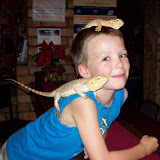Outback Adventures II
Jan 13-15
In the interests of time (I’ve got a lot of catching up to do) I’m not posting any photos in this blog and you can view all of our Outback photos at our web album:
 |
| Adelaide to Darwin |
Time zones in Australia are the most bizarre I have ever seen and can result in some very confused travelers. Queensland doesn’t subscribe to Daylight Savings and New South Wales does. Different states switch from Standard to Daylight Savings at different times and many border towns have the option of following whichever state they choose. There is only a half hour time difference between Victoria and South Australia and another hour change when crossing into the Northern Territory (don’t ask me why, but I think it has something to do with Daylight Savings again). I heard of one backpacker who almost got into a fist fight at a library in Victoria border town over an internet terminal he had booked for 2:30pm; turns out that the border town in question was on South Australia time and it was only 2pm. Something similar happened to us when we stopped for the night in Erldunda at the turn-off to Kings Canyon and Uluru (aka Ayers Rock). We wanted to get an early start so that we could get to Kings Canyon before the temperatures soared into the high 30’s, so we set our alarm for 6am and were on the road by 7:15am. When I went to drop the key at the office, I found it locked (even though the sign said they opened at 7am) and the gas pumps were closed, too. We didn’t think too much of it until we stopped for gas at a station a little way down the road and were told that they didn’t open until 7am. It was only then that we realized that the clocks had turned back an hour when we crossed into the Northern Territory and it was only 6:30am. It turned out to be a blessing in disguise, though, as we got to see lots of wildlife along the roadside, including wild camels, dingoes, wedge-tailed eagles, emus and, of course, roos. We also made great time to Kings Canyon and managed to beat all the bus tours onto the trail around the canyon rim (although it was still bloody hot at 35 degrees Celsius). By the end of our 6km hike, we were all drenched with sweat and covered with flies but happy to have seen the beautiful canyon.
After spending most of the morning in Kings Canyon, we decided to head for Uluru that afternoon. Accommodation in the area was ridiculously expensive ($150/night and up) and we figured we might as well try to reduce the number of nights we spent there. I called ahead to let the campground at Ayers Rock Resort know we were arriving a day early and the receptionist apologized and told me they were all booked up for the night. When I asked if they had anything else, she told me they did have one cabin that didn’t have a TV and that we could have it for $80/night. Needless to say, I jumped on that and we ended up paying the same amount for two nights that we were expecting to pay for one. The irony was that when we arrived, we had a perfectly functional TV. I’m still trying to figure that one out.
We spent the next two days enjoying the scenery at Kata Tjuta (The Olgas) where we hiked the Valley of the Winds Walk and Uluru (Ayers Rock) where we walked the perimeter but, out of respect for the local Aboriginals’ wishes, didn’t do the climb (it was too hot, anyway). In my opinion, Kata Tjuta, with its 28 huge red mounds, is even more impressive than Uluru and we were awestruck by its beauty and size. Over the past fifteen years or so, the Australian government has come a long way in recognizing Aboriginal rights and customs and have incorporated a lot of their history and culture into the area by building a large cultural centre. Unfortunately, aboriginal custom dictates that many of their stories and legends remain secret with some that are known only to one or the other of the sexes. This is also the reason Ayers Rock and The Olgas are now known by their traditional names and many attempts are being made to respect sacred areas at the sites and to educate the tourists who visit. While many scorn these measures, we respected the recognition being made to the area’s native people and applauded the Australian government for their efforts. There is even a “Sorry Book” inside the cultural centre which contains hundreds of letters of apology written by Australians who were returning bits and pieces of the sacred rock which they had taken as mementos on previous visits. We were also so impressed with the Aboriginal dot art that we ended up buying a few pieces when we visited Alice Springs a few days later.
Tags: Australia, Ayers Rock, Kings Canyon, Olgas, Travel, Uluru

Leave a Reply